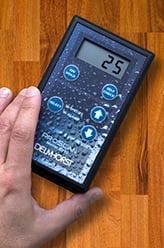 Recently, Delmhorst introduced its second pinless moisture meter product: ProScan. So, today, we want to talk about pinless moisture meters and how they work, as well as some of the special functions of the ProScan and how to use them.
Recently, Delmhorst introduced its second pinless moisture meter product: ProScan. So, today, we want to talk about pinless moisture meters and how they work, as well as some of the special functions of the ProScan and how to use them.
How Pinless Moisture Meters Work
Pinless meters such as ProScan operate in a completely different fashion from standard pin-type meters. Where pin-type meters use the principle of electrical resistance to measure moisture in wood and other materials, pinless meters use radio waves to scan materials instead, reading the fluctuations in the electromagnetic wave to establish the presence and amount of moisture in the material.
To take readings, users of a pinless meter simply press the scanning plate of the pinless meter to a flat surface on the material to be tested and activate the meter. Within a couple of seconds, the user has a moisture reading.
Advantages of Pinless Moisture Meters
Pinless meters have a few unique benefits that make them desirable to professionals in a number of fields.
First, pinless meters are a non-invasive option for testing moisture. Why is this such a big benefit? Because pinless meters don’t have to penetrate the surface of the material to be tested, they can give users a reading for moisture without leaving pin hole blemishes. If you're testing materials that you don’t want to leave with visible marks, then a pinless meter is the best tool for the job.
Another benefit of using a pinless meter is that it can scan for moisture in a much larger area per reading than a pin-type meter. This makes pinless meters ideal for rapidly identifying moisture pockets in materials like flooring lumber. Professionals can use pinless meters to take a reading in one spot, lift the meter, and press it down at another spot further along the material being scanned to get another reading in just a few seconds. The speed at which this process can be repeated allows users of pinless meters to get readings from much larger samples of materials much more quickly than they could with pin-type meters.
While pinless meters do have some limitations, such as needing a sufficiently thick material with a flat surface to scan, the benefits of having these devices are enough that nearly any professional who regularly has to take moisture readings in the materials that they’re working with would do well to keep one of these moisture testing devices handy.
About ProScan Pinless
The ProScan pinless moisture meter is the second pinless meter from Delmhorst and is a follow-up to the TechScan pinless meter. This particular pinless meter is geared towards professionals who work with many different kinds of wood, such as furniture and flooring manufacturers, who need a non-destructive method for testing lumber.
Designed to be lightweight and compact, being just over half a pound in weight (8.5 oz.) and measuring 5-5/8” x 3-5/16” x 1-1/14” (slightly larger than the latest generation smartphone from a company named after a certain fruit), ProScan is small enough to go most anywhere you can, while being big enough to produce results.
Beyond being lightweight and easy to use, ProScan boasts a range of other benefits and features, including:
-
Digital Display. One of the most immediately noticeable differences between ProScan and its predecessor, TechScan, is the digital display on the ProScan. It’s bright, clear, and easy to read, making it simpler to interpret readings by giving users a clear number.
-
Built-in Battery and Calibration Checks. When you’re checking moisture in materials, it’s important to know that the moisture meter you’re using is giving you accurate readings. With a built-in battery and calibration check, you can test your meter in the field wherever you are and know that you’re getting accurate results.
-
Hold Function. Get readings in hard to reach places by using the hold function to keep the last reading displayed on the screen until you’ve had a chance to read it.
-
Readings over the Range of 5% to 30% MC in Wood. With a range of 5 to 30 %MC in wood, the ProScan can tell you if your lumber has too much moisture, too little moisture, or is just right with ease.
-
Species Corrections. Different types of wood have different specific gravities, which influence the readings given by any pinless moisture meter. Most meters are calibrated for a single type of wood and require you to manually adjust readings based on a conversion formula for the wood being scanned. With the ProScan, there are built-in species corrections for wood types that range from .30 SG to .80 SG so that you get the actual %MC of the wood without the extra work of doing a manual conversion. Simply set the meter for the specific gravity of the wood you’re working with before you start taking readings.
-
Reference Scale. For professionals who have to work with materials other than wood, the ProScan has a secondary reference scale for non-wood materials such as drywall.
As with all of Delmhorst’s moisture testing devices, the ProScan is backed by Delmhorst’s comprehensive one-year warranty.
Learn more about how pinless moisture meters such as the ProScan are used, and how you can get one for your moisture measuring needs today!

Comments